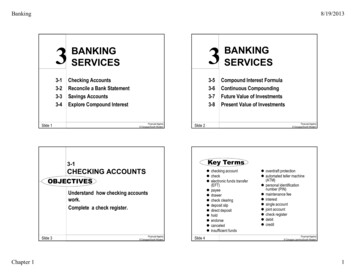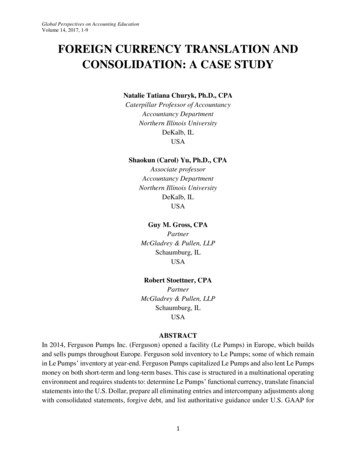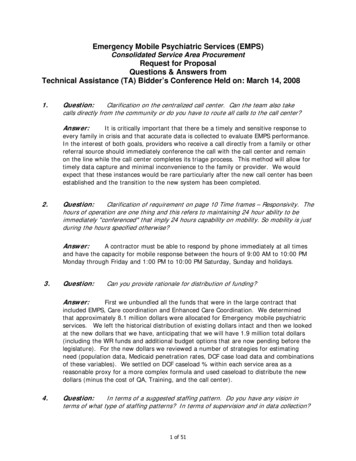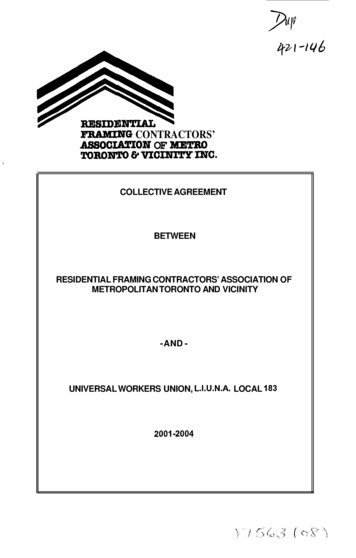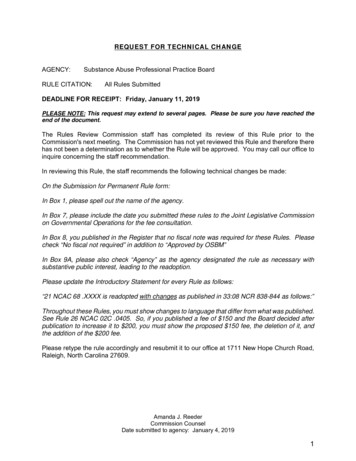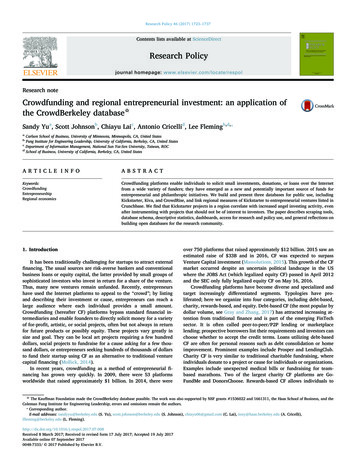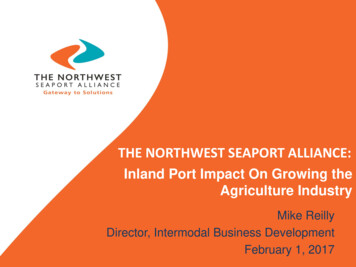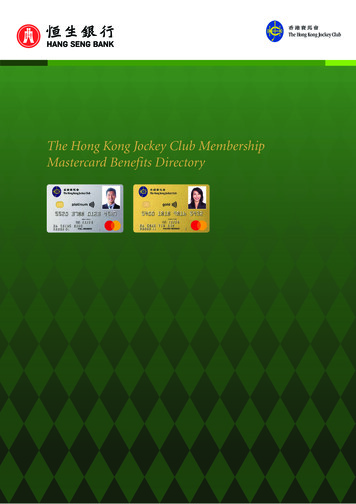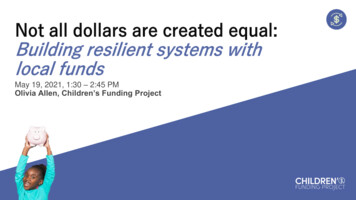
Transcription
Not all dollars are created equal:Building resilient systems withlocal fundsMay 19, 2021, 1:30 – 2:45 PMOlivia Allen, Children’s Funding Project
CHILDREN’SFUNDINGPROJECTWe help communities and states expandequitable opportunities for children andyouth through strategic public financing.Children’s Funding Project is structured to: Increase understanding of the policy tools availablefor strategic financing.Strengthen local capacity by providing training,tools, and coaching.Showcase and elevate the successes and lessonslearned from communities.Build momentum for a more pro-active approachto children’s funding.
FEDERAL COVID-19 RELIEF FUNDING FOR KIDS:A year in review“Cradle-to-Career Guide to Federal Relief Funding For Kids During and Beyond COVID-19”
Funding Stream/ProgramFFCRACARESCRRSAA 852 millionCORP. FOR NATIONAL AND COMMUNITY SERVICE (CNCS)GENERALEDUCATIONCOMMUNITY DEVELOPMENT BLOCK GRANTS (CDBG) 5 billionCOMMUNITY SERVICES BLOCK GRANTS (CSBG) 1 billion 30.75 billionPUBLIC K-12 AND HIGHER EDUCATION 81.9 billionCHILD CARE FUNDING (CCDBG OR CHILD CARE STABILIZATION) 3.5 billion 10 billion 39 billionHEAD START 750 million 250 million 1 billionHOME VISITING (MIECHV) 150 millionCHILD ABUSE PREVENTION AND TREATMENT 250 million 45 millionTITLE IV-B AND E PROGRAMSCHILD WELFARENUTRITION 485 million 20 millionFAMILY UNIFICATION PROGRAM VOUCHERSFAMILY VIOLENCE PREVENTION AND SERVICES 45 millionRUNAWAY AND HOMELESS YOUTH ACT 25 million 50 millionPROJECT AWAREBEHAVIORALHEALTH 165.2 billion 3 billionIDEA PARTS B AND CEARLY CARE ANDEDUCATIONARP 20 millionYOUTH SUICIDE PREVENTION 10 millionNATIONAL CHILD TRAUMATIC STRESS NETWORKWIC 500 millionTHE EMERGENCY FOOD ASSISTANCE PROGRAM 400 millionSNAP 30 million 10 million 490 million 450 million 15.8 billion 400 million
EXAMPLES OF COMPREHENSIVE SUPPORTS FOR CHILDREN& FAMILIES IN THE AMERICAN RESCUE PLANEARLY CAREANDEDUCATION 39 billion – ChildCare DevelopmentFlexible Funding/ChildCare StabilizationFundEDUCATION 122.8 billion –Elementary andSecondary SchoolEmergency ReliefFund (ESSER III) 39.6 billion – HigherEducation EmergencyRelief Fund (HEERF III) 1 billion – Head Start 3 billion – IDEA PartsB&C 2.75 billion –Emergency Assistanceto Non-Public Schools 150 million – HomeVisitingNUTRITION 852 million -Corporation for Nationaland Community Service 490 million –Increase funding levelfor WICBEHAVIORALHEALTHOTHERIMPORTANTSUPPORTS 80 million –Pediatric MentalHealth Care Access 350 billion–Coronavirus Stateand Local FiscalRecovery Funds 20 million – YouthSuicide Prevention 21.6 billion –Emergency RentalAssistance 10 million – NationalChild Traumatic StressNetwork 250 million – ChildAbuse Prevention andTreatment
QUESTIONS FOR THECHAT BOX:What does your community need in order toimplement the American Rescue Plan ActDollars impactfully?
FEDERAL FUNDINGBENEFITSCHALLENGESCan move a lot of chocolatemoney quicklyImpreciseCan redistribute wealth where it’smost neededConsolidates administrativeburdenDifficult to ensure it gets to thosewho need it mostRigid/inflexible
How can youleverage localresources toMAXIMIZEand SUSTAINfederal relieffunding?What steps can we take to maximize andsustain the impact of federal relief dollars? Create a strategic financing plan foryour community Use ARPA funds as a down-paymenton a long-term local investment Invest in administering infrastructurethat can coordinate/collaborateacross systems Create a strong narrative
Create astrategicfinancing plan A strategic financing planidentifies what we’re currentlyspending, models the cost to fillthe gap between currentneed/spending and our goals, andidentifies revenue sources to fillthat gapCurrent InvestmentHow much money, if any, is currently beinginvested in key parts of the strategic plan?Cost to Fill the GapWhat will it cost to scale currently fundedactivities? What will it cost to fund activities thatdo not currently exist or are not yet funded?New Revenue Sources to Fill theGapWhat revenue streams can we use to pay foridentified costs? (& what revenue streams canwe use to continue investments we make nowwith ARPA ?)Make a planSustain the investmentInvest in infrastructureFiscalmappingCostmodelingRevenue &innovativefinancingoptionsCreate a strong narrative
A fiscal map answers the questions WHOspends HOW MUCH and on WHAT?FEDERALapprenticeshipsacademic supportscollege access servicescommunity basedjuvenile justice servicescultural educationdual generationearly childhoodEmploymentfinancial educationfoster supportsgang prevention/violence preventionhealth educationhealth serviceshealth and wellnesshomeless youth servicesSTATECITYPHILANTHROPYPROGRAMS AND SERVICES FOR CHILDREN &YOUTH IN SAN ANTONIO & BEXAR COUNTYCOUNTYleadership developmentlegal supportmental/behavioral healthmentoringprovider outreachtraining and assistancerecreational activitiessexual health educationor servicessportsstreet outreach servicessubstance abuseSTEM/technology
What data is included?CHARACTERISTICDEFINITIONEXAMPLEFunding LevelWhere is funding coming from? (federal, state, city, county,philanthropy)CityBudget HolderWhat is the department or agency in charge of the fundingstream?Human ServicesFunding sourceDifferent funding levels/budget holders get their funding fromdifferent sources.General FundFunding recipientWho gets and uses the funding to administer a program orservice?San Antonio School DistrictDollar amountHow much funding are we talking about? 1,412,780.00Funding stream nameUsually the name of the actual program or serviceAfter School Challenge ProgramProgram outcomeareaConnected, Safe & Stable, Healthy, Educated, EmployableEducatedService typeRemember the program and service types we listed earlier?Academic Supports
Why create a fiscal map?UnderstandcurrentinvestmentsAlignresourceswith goalsCoordinatesupports andservicesMaximizefundingopportunitiesIdentify newareas forattention,efficiency andinnovationNEW EMERGENT REASONS: Determine the baseline funding pre COVID-19 budget deficits Plan for equitable recovery of funds to enhance programs andservicesMake a planSustain the investmentInvest in infrastructureCreate a strong narrative
Buncombe County Early Childhood FinancingWhat’s thecost?But where do wefind the money tofill the gap?
TRUE COST OF CARE!What’s thecost? 251 million:True cost of carewithrecommendedstaffing structureand salary levels 74- 100 million: Gapbetween recentsubsidy investmentlevels and true cost ofcare for infants andtoddlers currentlyparticipating in WIShares. 17.5 million:Estimatedparent copayFY20 Infant ToddlerSubsidy WI SharesSubsidy PaymentsBut where do wefind the money tofill the gap? 159,506,674KEY FINDINGSFROMWISCONSIN:INFANTTODDLER CHILDCAREINVESTMENTGAPCOST OF INFANT TODDLER CARE VS CURRENT SUBSIDIZEDINVESTMENT
REVENUE OPTIONS & FUNDING MECHANISMSCommonInnovativeCity or County dollarsDedicated public funds (set aside or new tax)State dollarsCommunity Benefit AgreementsFederal dollarsIndividual or Business Tax creditsLocal United WayOpioid Settlement dollarsLocal FoundationNational FoundationIndividual DonorsCorporationsMedicaid reimbursementsCommunity Reinvestment Act agreementsProfits from publicly held assetsReforming tax exemptionsPILOT recaptureFee Based ServicesIn kind facilities usageREAD: Innovative Financing to Expand Services So Children Can Thrive
Use ARPA funds as a downpayment on a long-term localinvestmentWho is responsible for sustaining the investment made withARPA funds? Embed ARPA investments and policy changes into your local budget tocement this as a core value of your community.Make a planSustain the investmentInvest in infrastructureCreate a strong narrative
LOCAL FUNDINGWhy pursueLOCAL,PUBLIC,DEDICATEDfunding forchildren &youth?Make a planSustain the investment Nimble & flexibleResponsive to local contextMissing piece of the publicfunding landscapeEnables innovation PUBLIC FUNDING Significant investmentAccountable infrastructureCommunity-drivenDrives provider equityDEDICATED FUNDING SustainableBuilds & addresses a stable systemCoordinated, consistent, long-term dataReduces siloesInvest in infrastructureCreate a strong narrative
LOCAL DEDICATED CHILDREN’S FUNDSCommunity Children’sService Fund ofLincoln CountySeattle Familiesand Education LevyBest Starts forKids King CountyBoone County Children’sServices FundChildren’s CommunityServices FundSt. Charles CountyFranklin CountyChildren’s Services FundCommunity Children'sServices FundSt. Louis CityChildren's ServicesFund St. Louis CountyKent County EarlyChildhood MillageMultnomah CountyPreschool for AllHumboldt CountyMarijuana TaxPreschool Promise,DaytonPortland Children'sServices LevyYolo CountyMarijuana TaxRichmond KidsFirst InitiativeChildren and YouthFund BaltimoreOakland Fund forChildren and YouthCincinnati PreschoolPromiseChildren and YouthFund San FranciscoSanta CruzMarijuana TaxCapitola Hotel TaxKids First,City of AspenRight Start Project,Summit CountySummit Pre-KProgramChildren’s Trust ofAlachua CountyStrong StartSan Miguel CountyHuman Services SafetyNet Mill LevyBoulder CountyChildren's Services Fundof Okeechobee CountyChildren's ServicesFund of St. Lucie CountyDenver PreschoolProgramChildren'sServices Fund ofJackson CountyLafayette CountyChildren's Services FundChildren’s Services FundOf Escambia CountyPre-K forSan AntonioSustain the investmentChildren's ServicesCouncil of Martin CountyChildren's Services Fundof Palm Beach CountyJuvenile Welfare BoardFund of Pinellas CountyJefferson CountyChildren’s ServicesFundMake a planChildren’s ServicesFund Of Leon CountyChildren's ServicesCouncil of Broward CountyThe Children’s Trust ofMiami-Dade CountyManatee County DedicatedMillage for ChildrenInvest in infrastructureChildren's Board and Fundof Hillsborough CountyCreate a strong narrative
LOCAL DEDICATED CHILDREN’S FUNDS –common revenue mechanismsSALES Aspen, COMissouri Children’s ServicesFundsSan Antonio, TXDenver, COPROPERTY Baltimore, MDKent County, MISt. Louis City, MOKing County, WASeattle, WABoulder County, COSan Miguel County, COCincinnati, OHPortland, ORSPECIAL TAXDISTRICT Florida’s Children’s Services CouncilsFor greater detail on these mechanisms, read: Funding Our Future:Generating State and Local Tax Revenue for Quality Early Care andEducationMake a planSustain the investmentGROSS RECEIPTSTAXINCOME TAX Multnomah County, ORDayton, OH San Francisco, CAHOTEL TAX Capitola, CASET-ASIDEMARIJUANA TAX Yolo County, CA Humboldt County, CA Santa Cruz, CAInvest in infrastructure Oakland, CASan Francisco, CARichmond, CACreate a strong narrative
Early childhood funding on local ballots inNovember 2020Make a planSustain the investmentNameAnnual Rev.% supportPreschool for AllMultnomah County, OR 202 million by202664.1%Prop RCity of St. Louis, MO 2.3 million56.1%Escambia Children’s TrustEscambia County, FL 7.5 million61%Children’s Services Fund of LeonCountyLeon County, FL 7.5 million65.8%Pre-K 4 SA ReauthorizationSan Antonio, TX 36.4 million73.3%Measure XSan Joaquin, CA 750,000 – 1.25million64.5%Invest in infrastructureCreate a strong narrative
Demographics of 2020 local dedicated fundefforts90% of community nonwhite% of children under 100% FPL80NOTE: in 2020, under 100%FPL was 12,760 for anindividual, and 4,480 for eachadditional household member,so 26,200 for a family of four.70Percent6050403027.9616.820US Census Bureau,AmericanCommunity Survey,July 1, 2019100Make a planSustain the investmentInvest in infrastructureCreate a strong narrative
Politics of 2020 local dedicated fund efforts90% voter support for Biden% voter support for campaign807060Percent51.4504030201000Make a planSustain the investmentInvest in infrastructureCreate a strong narrative
First StepsKent MillageKent County, MichiganAnnual Revenue: 5.7 millionYear established: 2018Type of Revenue: Property taxLevy amount: 0.25 per 1,000What it funds: Early childhoodAdministrating infrastructure: FirstSteps KentOngoing goals of the Ready by Five Early Childhood Millage:INCREASE EARLYLEARNINGOPPORTUNITIESAND CHILD HEALTHby increasing access toquality programming forexpecting mothers andchildren ages 0-5 in KentCountyINCREASE CROSSSECTORCOLLABORATIONbetween providers to ensurefamilies are being connectedwith needed services in theform of a warm handoffthrough referrals and datasharingREDUCE OUTCOMEDISPARITIESacross specific targetpopulations by ensuringculturally relevant andinclusive services andsupporting programs thatserve traditionallyunderserved communitymembersHOW?By investing in programs that contribute to four indicators of kindergartensuccess: Parents will have increased access to resources and information Mother’s health and wellbeing Children are developmentally on track Children are healthyCommunity-based organizations apply for funding to provide services such ashome visiting, play and learn groups, developmental screening, and navigationsupport to help families access the help they need and want.
Best Starts forKidsBest Starts for Kids invests in 4 key areas:INVESTING EARLY (prenatal to 5): King County, WashingtonAnnual Revenue: 65 millionYear established: 2015SUSTAINING THE GAIN (5 – 24): Type of Revenue: Property taxLevy amount: 0.14 per 1,000Post-partum breastfeeding supportHome visitingEarly Supports for Infants andToddlers (developmental)Before-, after-, and summer schoolprogramsTrauma-informed schoolsWork Training Education programsCOMMUNITIES MATTER: What it funds: cradle-to-careerprograms and servicesSupporting Communities ofOpportunity to create communitypartnerships and build capacityPREVENTING HOMELESSNESS:Administrating infrastructure:Dept. of Community and HumanServices Best Starts for Kids’ Youth andFamily Homelessness PreventionInitiative
WHAT ARE THE STEPS TO RAISING PUBLICREVENUE VIA BALLOT MEASURE?1. System-buildingIdentify shared goals & desired outcomes for children and families, andstrengthen a convening entity (advocacy group or intermediary)2. Quantify the gapConduct fiscal mapping, cost-modeling, and needs analysis to determine thegap between current funding and funding needed3. Select a revenue mechanismResearch the legally feasible revenue-generating mechanisms and use the 8other guiding questions to select one4. Build a coalition5. Secure ballot placement6. Run a winning campaignMake a planSustain the investmentInvest in infrastructureCreate a strong narrative
Invest inadministeringinfrastructureWho is responsible foridentifying and meeting theneeds of children, families,and providers in yourcommunity? A children’s cabinet? A collective impact backbone organization? A local dedicated fund? A United Way?Make a planSustain the investmentRole of administering infrastructure inARPA funding: Advocate for allocation of funding toequitable recovery Identify and direct funding to areas ofhigh need/disparate impact Engage providers who have notpreviously been engaged, identify accessbarriers to receiving funding Create streamlined application processes Monitor and collect data Monitor and audit funding to ensure it isgetting to those with least access &highest needInvest in infrastructureCreate a strong narrative
Invest inadministeringinfrastructureCollaborate andcoordinate acrosssystemsLocal, dedicated children’s fundsprovide a unique layer ofinfrastructure for MAXIMIZING andSUSTAINING progress made by ARPAfunds.Make a planSustain the investmentEx: Ready by Five in Kent County, MI,administered by First Steps Kent Formed the Kent Child Care Crisis ResponseTeam (March 20, 2020) and the KentCounty Shared Services Alliance to identifyand meet the needs of child care providers,and identify available slots foremergency/essential workers This positioned First Steps Kent toadminister 450,000 of CARES Act Fundingfor Kent County, and provide the KentCounty CARES Act Program for LicensedChild Care Business (TA including HumanResources, Tax prep, tech support,loan/grant application support)Invest in infrastructureCreate a strong narrative
Invest inadministeringinfrastructureEx: Children’s Services Council ofMartin County, FLCollaborate andcoordinate acrosssystemsLocal, dedicated children’s funds providea unique layer of infrastructure forMAXIMIZING and SUSTAINING progressmade by ARPA funds.Make a planSustain the investment Expanded a “Community FundingCollaborative” of funders anddeveloped a one-stop, multi-funderapplication for COVID-19 related needsto reduce administrative burden andfoster coordination of funders to meetneed. Tracked and met needs of providers,particularly those of OST/summerproviders faced with new PPE andfacilities requirements. Participated in grant application reviewfor local dollars from CARES Act Fundingand will do so with ARPA Funding.Invest in infrastructureCreate a strong narrative
Create a strongnarrativeWhen advocating for the allocation of ARPA dollars or creation of a local dedicated fund, it’simportant to present a BOLD, OPTIMISTIC vision for the future. Emphasize the positive impact your community can have with ARPA or local dollars. Draw connections between spending and positive well-being. Communicate clear roles that the federal, state, and local governments can play on the sameteam Present the opportunity we have now to make choices that impact our community and ourfuture.NOTE: It is no secret that there are going to be those who are looking for ARPA resources to fail. Besure to document how dollars are spent, data on the impact, and cost to sustain the impact.Make a planSustain the investmentInvest in infrastructureCreate a strong narrative
Create a strongnarrativeBut what if people argue that the federal funding from ARPAshould be enough? First – remind them about that I Love Lucy episode.Administering these dollars well takes investments ininfrastructure at the local level. Frame ARPA dollars as a down-payment on a long-terminvestment in our child- and youth-serving systems, so theywill be more resilient in the future. Remind them that any gains made now will need to besustained.Make a planSustain the investmentInvest in infrastructureCreate a strong narrative
NOWWHAT? Create a strategic financing plan foryour community Use ARPA funds as a down-paymenton a long-term local investment Invest in administering infrastructurethat can coordinate/collaborateacross systems Create a strong narrative
QUESTIONS?
THANKYOU!Please contact Olivia atolivia@childrensfundingproject.orgChildren’s Funding Project’s Latest Report:with any questions!
PUBLIC K-12 AND HIGHER EDUCATION 30.75 billion 81.9 billion 165.2 billion IDEA PARTS B AND C 3 billion CHILD CARE FUNDING (CCDBG OR CHILD CARE STABILIZATION) 3.5 billion 10 billion 39 billion
